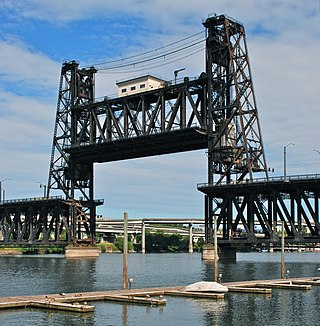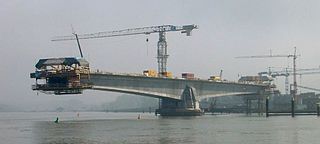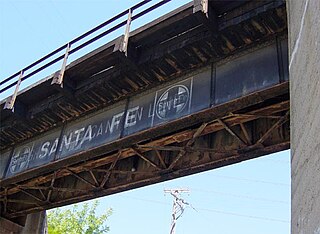
The Steel Bridge is a through truss, double-deck vertical-lift bridge across the Willamette River in Portland, Oregon, United States, opened in 1912. Its lower deck carries railroad and bicycle/pedestrian traffic, while the upper deck carries road traffic, and light rail (MAX), making the bridge one of the most multimodal in the world. It is the only double-deck bridge with independent lifts in the world and the second oldest vertical-lift bridge in North America, after the nearby Hawthorne Bridge. The bridge links the Rose Quarter and Lloyd District in the east to Old Town Chinatown neighborhood in the west.

The Eads Bridge is a combined road and railway bridge over the Mississippi River connecting the cities of St. Louis, Missouri, and East St. Louis, Illinois. It is located on the St. Louis riverfront between Laclede's Landing to the north, and the grounds of the Gateway Arch to the south. The bridge is named for its designer and builder, James Buchanan Eads. Work on the bridge began in 1867, and it was completed in 1874. The Eads Bridge was the first bridge across the Mississippi south of the Missouri River. Earlier bridges were located north of the Missouri, where the Mississippi is narrower. None of the earlier bridges survived, which means that the Eads Bridge is also the oldest bridge on the river.

A cantilever bridge is a bridge built using structures that project horizontally into space, supported on only one end. For small footbridges, the cantilevers may be simple beams; however, large cantilever bridges designed to handle road or rail traffic use trusses built from structural steel, or box girders built from prestressed concrete.

A truss bridge is a bridge whose load-bearing superstructure is composed of a truss, a structure of connected elements, usually forming triangular units. The connected elements, typically straight, may be stressed from tension, compression, or sometimes both in response to dynamic loads. There are several types of truss bridges, including some with simple designs that were among the first bridges designed in the 19th and early 20th centuries. A truss bridge is economical to construct primarily because it uses materials efficiently.

The Seven Mile Bridge is a bridge in the Florida Keys, in Monroe County, Florida, United States. It connects Knight's Key in the Middle Keys to Little Duck Key in the Lower Keys. Among the longest bridges in existence when it was built, it is part of the Overseas Highway in the Keys, which is part of the 2,369-mile (3,813 km) U.S. Route 1.

Dr. John Alexander Low Waddell was a Canadian-American civil engineer and prolific bridge designer, with more than a thousand structures to his credit in the United States, Canada, as well as Mexico, Russia, China, Japan, and New Zealand. Waddell’s work set standards for elevated railroad systems and helped develop materials suitable for large span bridges. His most important contribution was the development of the steam-powered high-lift bridge. Waddell was a widely respected writer on bridge design and engineering theory, as well as an advocate for quality in higher education engineering programs. The company he founded in 1887, 'J.A.L. Waddell, Consulting Engineer,' would eventually become the modern day Hardesty & Hanover, a leading moveable bridge engineering firm. Many of Waddell's surviving bridges are now considered historic landmarks.

A plate girder bridge is a bridge supported by two or more plate girders.

The MacArthur Bridge is a truss bridge that connects St. Louis, Missouri and East St. Louis, Illinois over the Mississippi River. The bridge was initially called the "St. Louis Municipal Bridge" and known popularly as the "Free Bridge" due to the original lack of tolls. Tolls were added for auto traffic beginning in 1932. In 1942, the bridge was renamed for Douglas MacArthur. The bridge was constructed to break the monopoly of the Terminal Railroad Association, which controlled two other bridges at St. Louis and charged what were viewed as unreasonable tolls.

The Frisco Bridge, previously known as the Memphis Bridge, is a cantilevered through truss bridge carrying a rail line across the Mississippi River between West Memphis, Arkansas, and Memphis, Tennessee.

The Quincy Rail Bridge is a truss bridge that carries a rail line across the Mississippi River between West Quincy, Missouri, and Quincy, Illinois, USA. It was originally constructed in 1868 for the Chicago, Burlington and Quincy Railroad, a predecessor of BNSF Railway.

The Burlington Bridge is a vertical-lift railroad bridge across the Mississippi River between Burlington, Iowa, and Gulfport, Illinois, United States. It is currently owned by BNSF Railway and carries two tracks which are part of BNSF's Chicago–Denver main line.

The Government Bridge or Arsenal Bridge spans the Mississippi River, connecting Rock Island, Illinois and Davenport, Iowa. The Iowa Interstate Railroad uses the upper deck of the bridge for its ex-Chicago and Rock Island Railroad route between Council Bluffs, Iowa and Chicago, Illinois. The lower deck carries automobile traffic between the two cities. It is located near Upper Mississippi Mile Marker 483, adjacent to the Mississippi River Lock and Dam No. 15. The current structure is the fourth at this location. The bridges all were built with a swing section to accommodate traffic navigating the river.

The Fort Wayne Railroad Bridge, listed as the Pennsylvania Railroad Bridge on the National Register of Historic Places, is a double-deck steel truss railroad bridge spanning the Allegheny River in Pittsburgh, Pennsylvania.

Crossing the Kansas River in Kansas City, Kansas, United States, the Highline Bridge is rare example of a double-tracked, double-deck railroad bridge designed for carrying railroad traffic on both levels. The bridge is owned and operated by the Kansas City Terminal Railway (KCTR) and provides access between the extensive rail yards on both sides of the river in the Argentine and Armourdale neighborhoods in Kansas City, Kansas, and other rail yards in Kansas City, Missouri.

The Lewis and Clark Viaduct are two nine span viaducts that cross the Kansas River in the United States. Designed by Waddell and Hedrick, the first viaduct, a four-lane, deck truss bridge, opened to the public on January 29, 1907, the second bridge, also of the deck truss design, opened to the public on November 12, 1962. It rises above the West Bottoms, and several sets of railroad tracks. The 1907 viaduct is notable for being the first roadway bridge to connect Kansas City, Missouri, with Kansas City, Kansas, non-stop all the way across. It is about 1.5 miles (2.4 km) long and carries Interstate 70/U.S. Route 24/U.S. Route 40/U.S. Route 169 (I-70/US 24/US 40/US 169). The I-670 Viaduct serves as a complementary to the viaduct, it was built in 1990 to the south.

Waddell & Harrington was an American engineering company that designed bridges from 1907 to 1915. It was formed in 1907 as a partnership of John Alexander Low Waddell (1854–1938) and John Lyle Harrington (1868–1942) and was based in Kansas City, Missouri, but had offices in Portland, Oregon, and Vancouver, British Columbia. The company designed more than 30 vertical-lift bridges for highways and railroads.

The Waddell "A" Truss Bridge, also known by its original name of Linn Branch Creek Bridge is one of two surviving examples of the "A" Truss Bridge type originated by John Alexander Low Waddell. It was originally completed in 1898 near Trimble, Missouri, and is currently located at English Landing Park in Parkville, Platte County, Missouri. The bridge was relocated in 1987 and listed on the National Register of Historic Places in 1991.

The Long Key Bridge, officially known as the Dante B. Fascell Bridge, is a bridge in the Florida Keys connecting Long Key and Conch Key, roughly halfway between Miami and Key West. At a length of nearly two and a half miles, it is the second longest bridge on the Overseas Highway after the Seven Mile Bridge. The current bridge opened in 1982, replacing the parallel Long Key Viaduct, which carried the Overseas Railroad from 1907 to 1935 and was repurposed for highway use shortly after.

The Waddell "A" Truss Bridge is standardized truss bridge design that was first patented in 1893 by prolific civil engineer John Alexander Low Waddell. The design provided a simple low-cost, high-strength solution for use by railroads across the United States and Empire of Japan for short spans of around 100 ft. According to the Historic American Engineering Record (HAER), "beyond its role in the growth of railroad transportation, the "A" truss is perhaps most historically significant when viewed within the context of Waddell's career and the emergence of the American bridge fabrication industry into international marketing."





















